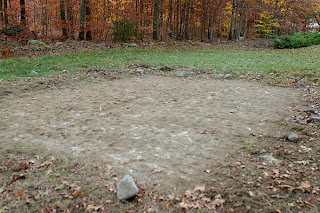Planting a Meadow
The title is not a metaphor - I am actually planting an actual meadow. Well, attempting to plant an actual meadow. OK, attempting to plant a small meadow-like area.
Part of our backyard is a swath of land with a utilities easement on it - we own the land, but the gas company has access rights and nothing can be built there. Previous owners planted grass back there and, so I've heard, kept it mowed like a lawn. I haven't continued this practice since 1) I have no desire to spend the time and energy to mow more lawn, and 2) I like my yard to provide as many natural habitats as possible (and a mowed lawn ain't much of a natural habitat). I would love to naturalize this entire back lawn, but it is a pretty big space and would require more time/effort/money to remove the existing grass than I am willing/able to give. So this summer I decided to start small.
I chose a small (~400 ft2) area to work with, figuring I can expand things in subsequent years if this preliminary work goes well. I started this project back in June, when, after mowing the grass short, I covered the area with some nylon tarps. I kept these tarps in place from June until this weekend. By keeping the area covered during the entire growing season, keeping the sun out and the temperature up, I was hoping to kill both the existing grass and a decent percentage of the grass/weed seeds lying dormant in the soil.

I pulled the tarps up this weekend and, sure enough, all vegetation was dead:
After some raking and hoeing up of dead grass tussocks, the area was ready to be sown:
By sowing seeds now, in November, in New England, I am accomplishing a couple of things. First, the wildflower and grass seeds I sow now will already be in place in the spring, ready to germinate as soon as conditions are right - this should give them a leg up (or at least an even footing) with any weed seeds out there now and I won't have to worry about working around my schedule or the unpredictable spring weather to plant. Second, some native wildflower seeds require a period of cold dormancy before they will germinate - I could have put the seeds in the fridge for the next few months, but why bother when winter can do a better job for me?
I wanted to plant a meadow, not just a wildflower garden, so I ordered both wildflower and grass seeds. I also wanted to use as many native plants as I could. After some online research, I ended up with a native wildflower seed mix from American Meadows and a short prairie grass mix from Prairie Frontiers. I augmented these with some additional native wildflower seeds. I bought enough seed for approximately 1,000 ft2, figuring I'd use half of it this year and the other half for next year's expansion.
Following a technique I found online, I split the seed I was going to use this year into two parts and mixed each part with approximately 10 parts of clean sand, which makes sowing the light, small wildflower seeds much easier. After thoroughly mixing the seed and sand, I sowed 1 part over the entire plot moving east-west and then sowed the 2nd part going north-south, thereby minimizing bare/sparse areas. The last thing to do, which is oh so important (so I've read), was to compact the seeds into the soil to ensure good seed-soil contact. Since I don't own a grass roller, I spent a half hour or so stomping around the sown plot, making sure my footprints covered every square inch of the ground.
Now I just sit back, enjoy the rest of the fall and winter, hope the birds don't eat too many of the newly sown seeds, and keep my fingers crossed for successful germination. I'll keep everyone posted.
Wildflowers sown:
Aquilegia canadensis (Eastern Red Columbine)
Asclepias incarnata (Red Milkweed)
Asclepias tuberosa (Butterfly Weed)
Aster novae-angliae (New England Aster)
Baptisia australis (Wild/False Blue Indigo)
Chamaecrista fasciculata (Partridge Pea)
Coreopsis lanceolata (Lance Leaf Coreopsis)
Eupatorium fistulosum (Joe Pye Weed)
Eupatorium maculatum (Spotted Joe Pye Weed)
Gaillardia pulchella (Indian Blanket)
Heliopsis helianthoides (Ox-Eye Sunflower)
Liatris spicata (Blazing Star)
Lobelia cardinalis (Cardinal Flower)
Lupinus perennis (Wild Perennial Lupine)
Monarda fistulosa (Wild Bergamot)
Oenothera biennis (Evening primrose)
Penstemon digitalis (Beard Tongue)
Rudbeckia hirta (Black-eyed Susan)
Rudbeckia submentosa (Sweet Coneflower)
Rudbeckia triloba (Brown-eyed Susan)
Salvia azurea (Tall Blue Pitcher Sage)
Solidago rigida (Rigid Goldenrod)
Solidago speciosa (Showy Goldenrod)
Grasses sown:
Andropogon scoparius (Little Bluestem)
Bouteloua curtipendula (Side Oats Gramma)
Bouteloua gracillis (Blue Gramma)
Koeleria cristata (Prairie June Grass)
Sporobolus heterolepis (Prairie Dropseed)



5 comments:
Well done! I'd like to see more people turn away from sterile lawns and into more naturalistic plantings. I removed or covered almost all the lawn at our home and replaced with a mixed planting of trees, shrubs and perennials. We have not regretted it. Great for bringing in bugs and birds!
All the best with your endeavor.
Adrian - thanks for the comment. Eventually, I'm hoping to convert the entire easement to meadow - I haven't measured it, but I'm estimating it somewhere around 4,000 square feet. Seems daunting, but hopefully this first foray will pan out and I can work from there, piece by piece.
Cool post. I'm from your neck of the woods (Cape Ann) originally. Since moving to Chicago, I've done lots of ecological restoration. I wouldn't begin to know what to do in New England. Most of the Massachusetts ecosystems that I'm familiar with are wooded ones- or wetlands.
any more photos of your meadow?
Nancy - Alas the whole planting was a colossal failure. Not sure what went wrong, but it never took off and I have not had the time nor energy to try again. :(
Post a Comment